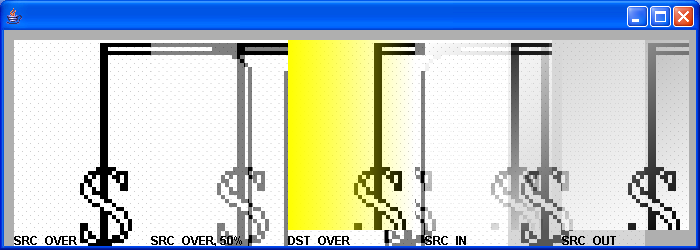Composite Effects

/*
* Copyright (c) 2000 David Flanagan. All rights reserved. This code is from the
* book Java Examples in a Nutshell, 2nd Edition. It is provided AS-IS, WITHOUT
* ANY WARRANTY either expressed or implied. You may study, use, and modify it
* for any non-commercial purpose. You may distribute it non-commercially as
* long as you retain this notice. For a commercial use license, or to purchase
* the book (recommended), visit http://www.davidflanagan.com/javaexamples2.
*/
import java.awt.AlphaComposite;
import java.awt.Color;
import java.awt.Font;
import java.awt.GradientPaint;
import java.awt.Graphics;
import java.awt.Graphics2D;
import java.awt.Image;
import java.awt.Rectangle;
import java.awt.Shape;
import java.awt.event.WindowAdapter;
import java.awt.event.WindowEvent;
import java.awt.geom.Area;
import java.awt.geom.Ellipse2D;
import java.awt.image.BufferedImage;
import javax.swing.JFrame;
import javax.swing.JPanel;
public class CompositeEffects extends JPanel{
Image cover; // The image we'll be displaying, and its size
static final int COVERWIDTH = 127, COVERHEIGHT = 190;
/** This constructor loads the cover image */
public CompositeEffects() {
java.net.URL imageurl = this.getClass().getResource("java2s.gif");
cover = new javax.swing.ImageIcon(imageurl).getImage();
}
// These are basic GraphicsExample methods
public String getName() {
return "Composite Effects";
}
public int getWidth() {
return 6 * COVERWIDTH + 70;
}
public int getHeight() {
return COVERHEIGHT + 35;
}
/** Draw the example */
public void paint(Graphics g1) {
Graphics2D g = (Graphics2D)g1;
// fill the background
g.setPaint(new Color(175, 175, 175));
g.fillRect(0, 0, getWidth(), getHeight());
// Set text attributes
g.setColor(Color.black);
g.setFont(new Font("SansSerif", Font.BOLD, 12));
// Draw the unmodified image
g.translate(10, 10);
g.drawImage(cover, 0, 0, this);
g.drawString("SRC_OVER", 0, COVERHEIGHT + 15);
// Draw the cover again, using AlphaComposite to make the opaque
// colors of the image 50% translucent
g.translate(COVERWIDTH + 10, 0);
g.setComposite(AlphaComposite
.getInstance(AlphaComposite.SRC_OVER, 0.5f));
g.drawImage(cover, 0, 0, this);
// Restore the pre-defined default Composite for the screen, so
// opaque colors stay opaque.
g.setComposite(AlphaComposite.SrcOver);
// Label the effect
g.drawString("SRC_OVER, 50%", 0, COVERHEIGHT + 15);
// Now get an offscreen image to work with. In order to achieve
// certain compositing effects, the drawing surface must support
// transparency. Onscreen drawing surfaces cannot, so we have to do the
// compositing in an offscreen image that is specially created to have
// an "alpha channel", then copy the final result to the screen.
BufferedImage offscreen = new BufferedImage(COVERWIDTH, COVERHEIGHT,
BufferedImage.TYPE_INT_ARGB);
// First, fill the image with a color gradient background that varies
// left-to-right from opaque to transparent yellow
Graphics2D osg = offscreen.createGraphics();
osg.setPaint(new GradientPaint(0, 0, Color.yellow, COVERWIDTH, 0,
new Color(255, 255, 0, 0)));
osg.fillRect(0, 0, COVERWIDTH, COVERHEIGHT);
// Now copy the cover image on top of this, but use the DstOver rule
// which draws it "underneath" the existing pixels, and allows the
// image to show depending on the transparency of those pixels.
osg.setComposite(AlphaComposite.DstOver);
osg.drawImage(cover, 0, 0, this);
// And display this composited image on the screen. Note that the
// image is opaque and that none of the screen background shows through
g.translate(COVERWIDTH + 10, 0);
g.drawImage(offscreen, 0, 0, this);
g.drawString("DST_OVER", 0, COVERHEIGHT + 15);
// Now start over and do a new effect with the off-screen image.
// First, fill the offscreen image with a new color gradient. We
// don't care about the colors themselves; we just want the
// translucency of the background to vary. We use opaque black to
// transparent black. Note that since we've already used this offscreen
// image, we set the composite to Src, we can fill the image and
// ignore anything that is already there.
osg.setComposite(AlphaComposite.Src);
osg.setPaint(new GradientPaint(0, 0, Color.black, COVERWIDTH,
COVERHEIGHT, new Color(0, 0, 0, 0)));
osg.fillRect(0, 0, COVERWIDTH, COVERHEIGHT);
// Now set the compositing type to SrcIn, so colors come from the
// source, but translucency comes from the destination
osg.setComposite(AlphaComposite.SrcIn);
// Draw our loaded image into the off-screen image, compositing it.
osg.drawImage(cover, 0, 0, this);
// And then copy our off-screen image to the screen. Note that the
// image is translucent and some of the image shows through.
g.translate(COVERWIDTH + 10, 0);
g.drawImage(offscreen, 0, 0, this);
g.drawString("SRC_IN", 0, COVERHEIGHT + 15);
// If we do the same thing but use SrcOut, then the resulting image
// will have the inverted translucency values of the destination
osg.setComposite(AlphaComposite.Src);
osg.setPaint(new GradientPaint(0, 0, Color.black, COVERWIDTH,
COVERHEIGHT, new Color(0, 0, 0, 0)));
osg.fillRect(0, 0, COVERWIDTH, COVERHEIGHT);
osg.setComposite(AlphaComposite.SrcOut);
osg.drawImage(cover, 0, 0, this);
g.translate(COVERWIDTH + 10, 0);
g.drawImage(offscreen, 0, 0, this);
g.drawString("SRC_OUT", 0, COVERHEIGHT + 15);
// Here's a cool effect; it has nothing to do with compositing, but
// uses an arbitrary shape to clip the image. It uses Area to combine
// shapes into more complicated ones.
g.translate(COVERWIDTH + 10, 0);
Shape savedClip = g.getClip(); // Save current clipping region
// Create a shape to use as the new clipping region.
// Begin with an ellipse
Area clip = new Area(new Ellipse2D.Float(0, 0, COVERWIDTH, COVERHEIGHT));
// Intersect with a rectangle, truncating the ellipse.
clip.intersect(new Area(new Rectangle(5, 5, COVERWIDTH - 10,
COVERHEIGHT - 10)));
// Then subtract an ellipse from the bottom of the truncated ellipse.
clip.subtract(new Area(new Ellipse2D.Float(COVERWIDTH / 2 - 40,
COVERHEIGHT - 20, 80, 40)));
// Use the resulting shape as the new clipping region
g.clip(clip);
// Then draw the image through this clipping region
g.drawImage(cover, 0, 0, this);
// Restore the old clipping region so we can label the effect
g.setClip(savedClip);
g.drawString("Clipping", 0, COVERHEIGHT + 15);
}
public static void main(String[] a){
JFrame f = new JFrame();
f.addWindowListener(new WindowAdapter() {
public void windowClosing(WindowEvent e) {
System.exit(0);
}
});
f.setContentPane(new CompositeEffects());
f.setSize(700,250);
f.setVisible(true);
}
}
Related examples in the same category